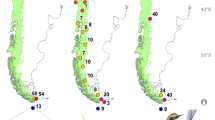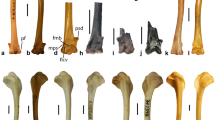Abstract
The species-level diversity of Madagascar’s lemurs has increased hugely over the last two decades, growing from 32 species in 1994 to 102 species in 2014. This growth is primarily due to the application of molecular phylogenetic analyses and the phylogenetic species concept to known populations, and few previously unknown lemur populations have been discovered during this time. We report on a new population of dwarf lemurs (Cheirogaleus sp.) from Nosy Hara, a 312-ha island in far northern Madagascar, which constitutes the northernmost distribution record for the genus. The dwarf lemurs appeared to show two characteristics of island populations—insular dwarfism and predator naïveté—that suggest a long isolation, and may thus represent an undescribed taxon. If this is the case, the dwarf lemurs of Nosy Hara are probably one of the rarest primate taxa on Earth.


Similar content being viewed by others
References
Dausmann KH (2000) Effective predation defence in Cheirogaleus medius. Lemur News 15:18–20
Diamond J, Case TJ (1986) Overview: introductions, extinctions, exterminations, and invasions. In: Diamond J, Case TJ (eds) Community ecology. Harper and Row, New York, pp 65–79
Fichtel C, Kappeler PM (2011) Variation in the meaning of alarm calls in Verreaux’s and Coquerel’s sifakas (Propithecus verreauxi, P. coquereli). Int J Primatol 32:346–361
Groeneveld LF, Weisrock DW, Rasoloarison RM, Yoder AD, Kappeler PM (2009) Species delimitation in lemurs: multiple genetic loci reveal low levels of species diversity in the genus Cheirogaleus. BMC Evol Biol 9:30
Groeneveld LF, Blanco MB, Raharison JL, Rahalinarivo V, Rasoloarison RM, Kappeler PM, Godfrey LR, Irwin MT (2010) MtDNA and nDNA corroborate existence of sympatric dwarf lemur species at Tsinjoarivo, eastern Madagascar. Mol Phylogenet Evol 55:833–845
Groves CP (2000) The genus Cheirogaleus: unrecognized biodiversity in dwarf lemurs. Int J Primatol 21:943–962
Groves CP (2001) Primate taxonomy. Smithsonian Institution Press, Washington DC
Groves CP (2005) Order primates. In: Wilson DE, Reeder DM (eds) Mammal species of the world: a taxonomic and geographic reference, vol 1. Johns Hopkins University Press, Baltimore, pp 111–184
Groves CP (2012) Species concept in primates. Am J Primatol 74:687–691
IUCN (International Union for Conservation of Nature and Natural Resources) (2015). 2001 Categories & Criteria (version 3.1). Available at: http://www.iucnredlist.org/static/categories_criteria_3_1, accessed 01.06.2015
Lei R, Frasier CL, McLain AT, Taylor JM, Bailey CA, Engberg SE, Ginter AL, Randriamampionona R, Groves CP, Mittermeier RA, Louis EE Jr (2014) Revision of Madagascar’s dwarf lemurs (Cheirogaleidae: Cheirogaleus): designation of species, candidate species status and geographic boundaries based on molecular and morphological data. Primate Conserv 28:9–35
Long JL (2003) Introduced mammals of the world: their history, distribution and influence. CSIRO Publishing, Clayton
Metcalf CJE, Hampson K, Gray A, Andrianirina R (2007) Herpetofaunal assemblages on seven offshore islands of northwestern Madagascar. Trop Zool 20:151–161
Mittermeier RA, Tattersall I, Konstant WR, Meyers DM, Mast RB (1994) Lemurs of Madagascar, 1st edn. Conservation International, Washington, DC
Mittermeier RA, Ganzhorn JU, Konstant WR, Glander K, Tattersall I, Groves CP, Rylands AB, Hapke A, Ratsimbazafy J, Mayor MI, Louis Jr EE, Rumpler Y, Schwitzer C, Rasoloarison RM (2008) Lemur diversity in Madagascar. Int J Primatol 29:1607–1656
Mittermeier RA, Louis EE Jr, Richardson M, Schwitzer C, Langrand O, Rylands AB, Hawkins F, Rajaobelina S, Ratsimbazafy J, Rasoloarison R, Roos C, Kappeler PM, MacKinnon J (2010) Lemurs of Madagascar, 3rd edn. Conservation International, Arlington
Mittermeier RA, Schwitzer C, Johnson S, Ratsimbazafy J (2013) Introduction. In: Schwitzer C, Mittermeier RA, Davies N, Johnson S, Ratsimbazafy J, Razafindramanana J, Louis EE Jr, Rajoelina S (eds) Lemurs of Madagascar: a strategy for their conservation 2013-2016. IUCN SSC Primate Specialist Group, Bristol Conservation and Science Foundation and Conservation International, UK, pp 5–11
MNP (Madagascar National Parks) (2012) Plan d’aménagement et de gestion du Parc National Nosy Hara. Madagascar National Parks, Antananarivo
MNP (Madagascar National Parks) (2014) Madagascar National Parks protected areas network strategic management plan 2014-2024. Madagascar National Parks, Antananarivo
Moat J, Smith P (2007) Atlas of the vegetation of Madagascar. Kew Publishing, Kew
Pedrono M (2008) The tortoises and turtles of Madagascar. Natural History Publications (Borneo), Kota Kinabalu
Raherilalao MJ (2010) Les oiseaux de l’archipel de Nosy Hara, au nord nord-ouest de Madagascar et la nouvelle distribution du gobe mouche de Ward (Pseudobias wardi). Madag Conserv Dev 5:48–54
Raia P, Meiri S (2006) The island rule in large mammals: paleontology meets ecology. Evolution 60:1731–1742
Schwitzer C, Mittermeier RA, Johnson SE, Donati G, Irwin M, Peacock H, Ratsimbazafy J, Razafindramanana J, Louis EE Jr, Chikhi L, Colquhoun IC, Tinsman J, Dolch R, LaFleur M, Nash S, Patel E, Randrianambinina B, Rasolofoharivelo T, Wright PC (2014) Averting lemur extinctions amid Madagascar’s political crisis. Science 343:842–843
Sih A, Bolnick DI, Luttbeg B, Orrock JL, Peacor SD, Pintor LM, Preisser E, Rehage JS, Vonesh JR (2010) Predator-prey naïveté, antipredator behavior, and the ecology of predator invasions. Oikos 119:610–621
Tattersall I (2007) Madagascar’s lemurs: cryptic diversity or taxonomic inflation? Evol Anthropol 16:12–23
Tattersall I (2013) Understanding species-level primate diversity in Madagascar. Madag Conserv Dev 8:7–11
Thiele D, Razafimahatratra E, Hapke A (2013) Discrepant partitioning of genetic diversity in mouse lemurs and dwarf lemurs—biological reality or taxonomic bias? Mol Phylogenet Evol 69:593–609
Wilson JM, Stewart PD, Fowler SV (1988) Ankarana—a rediscovered nature reserve in northern Madagascar. Oryx 22:163–171
Acknowledgments
We thank Ed Louis Jr., Shawn Lehman and Vola Ramahery for providing literature and information on known Cheirogaleus distributions, Russell Mittermeier and Anthony Rylands for comments which improved the clarity of the manuscript, and Letsara Rokiman for identification of the plant species in Fig. 2.
Author information
Authors and Affiliations
Corresponding author
About this article
Cite this article
Gardner, C.J., Jasper, L.D. Discovery of an island population of dwarf lemurs (Cheirogaleidae: Cheirogaleus) on Nosy Hara, far northern Madagascar. Primates 56, 307–310 (2015). https://doi.org/10.1007/s10329-015-0479-x
Received:
Accepted:
Published:
Issue Date:
DOI: https://doi.org/10.1007/s10329-015-0479-x




